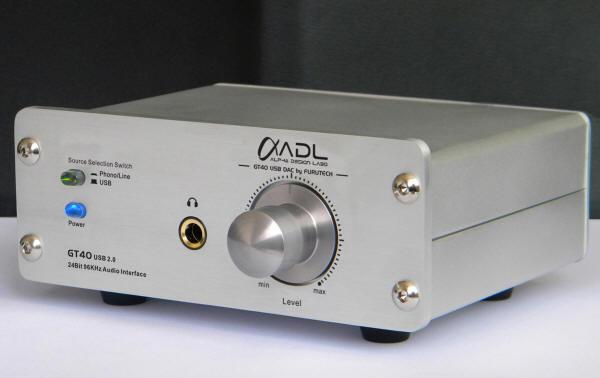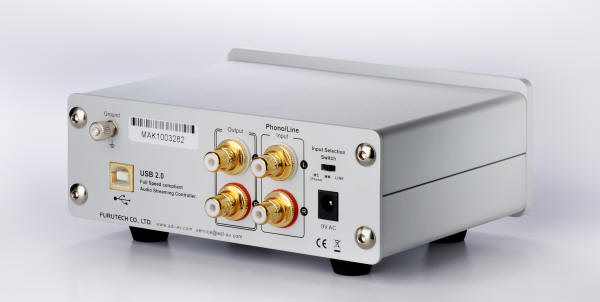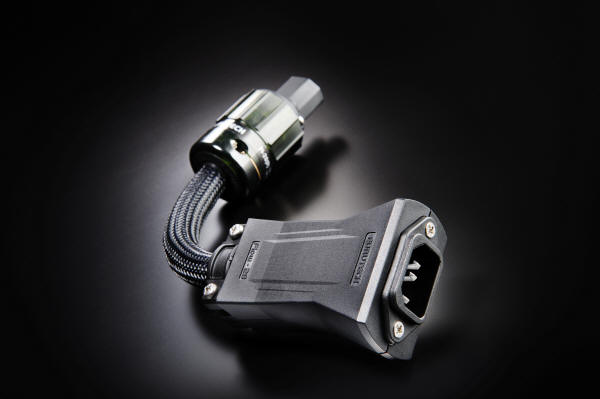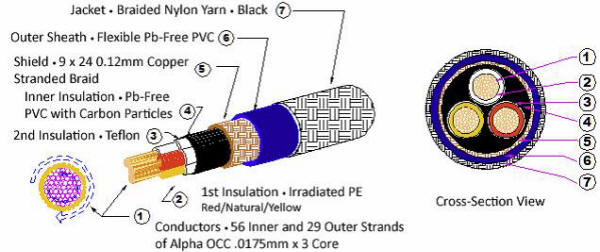|
You are reading the older HTML site
Positive Feedback
ISSUE
57
Impressions: A Two-Fer from
Furutech, being a brief account of the GT40 USB DAC and Flow-28 In-Line AC
Filter
[All photographs courtesy of Furutech]
The Furutech/Alpha Design Labs GT40 You know, things don't always have to be big to be good. Even in the august world of fine audio, with amplifiers that can take a forklift to put into place, and speakers the size of Aunt Matilda, sometimes you find products that win you over with their compact virtues. We do see this more in the world of digital audio, where advancing generations of chipsets make it easier and easier to shrink function into an ever more diminutive package. With more high-quality, high-resolution audio files available, it's inevitable that we'll see more players entering this market. And so we do. The USB interface in particular has been growing rapidly over the past few years, due mainly to the fact that it is ubiquitous in the world of computing. That's not to say that it's the best interface for high-resolution audio data transport; it isn't. Far from it. Alternatives like IEEE 1394 (Firewire), or AES/EBU, or (especially) AT&T ST glass were technically superior. But, as we all know, "technically best" doesn't always become the standard, any more than the politician who gets elected is always the "best" person for the job. And so, USB 2.0 has gotten "elected" by its very ubiquity to be what we have…very much like the Red Book standard in CDs. So, when the folks over at Furutech asked if I'd be interesting in checking out their ultra-compact GT40 USB 2.0 DAC and headphone combo, I told them sho' nuff! In fact, I had a pair of Sennheiser HD800 balanced headphones with a ¼" adapter that would work just fine for some critical listening, plus lots of 96/24 files on hard disk in our desktop reference system that would make for good times. (Real music, too. No Tibetan Yak music recordings.) With the world of computer-based higher resolution audio blasting off like a Saturn V, it's not surprising that we should see high-performance components that are slim and trim. In fact, the GT40 sits in the palm of my hand quite easily. It's about 6" wide, 2.5" high, and about 4" deep, making it easy to place just about anywhere on your desktop or listening room. On the other hand, it's built like a tank…feels like a couple of pounds in the hand… being heavily shielded internally. Furutech takes special pride in the quality of their shielding and resonance control… as they should, in my years of experience with their designs. Being a Furutech product, what else would you expect but top-of-the-line build quality? The front of the unit has a power button (glows blue), plus a source select input button that allows switching between USB (glows green) and analog phono/line (glows red). There's a ¼" stereo jack for headphones, with a recommended headphone impedance range of 16-300 Ohms. Volume is controlled by a large pot with a smooth and very satisfactory feel to it… closer to ALPS than to also-ran.
The rear of the GT40 has a USB A port for digital input, a pair of RCAs for phono- or line-level analog input, and a pair of RCA analog output jacks. The analog in is switchable between MC (62.5 dB gain @ 1 kHz + 6 dB line level gain; 0.4mV maximum input voltage) and MM (48.5 dB @ 1 kHz + 6 dB line level gain; 5.0mV maximum input voltage) inputs (47k Ohms loading on both). There is a third switch position for line input, with a maximum input voltage of 1V. The line output is rated at 1V. The GT40 is externally powered, which is a major plus; there are too many devices that rely on the often uncertain power from a computer's USB port, with results that are often underwhelming… or even completely unreliable. The GT40 DAC supports playback resolutions up to 96kHz/24 bits, and recording resolutions of 32kHz, 44.1kHz, 48kHz, and 96kHz, up to 24 bits. By sticking to 96/24, which is the current USB resolution limit in Windows using the native ASIO driver (breathtakingly stupid limit, this… Apple left this behind a while back), the GT40 minimizes any potential driver issues in Windows 7 and Windows Vista, since the native OS will recognize the device and automatically install the ASIO driver that the DAC requires. In fact, Windows 7 (64-bit) immediately recognized the GT40 when I fired it up and plugged it into my trusty HP Pavilion DV8t. Biff! Done! Setup So, what can I say? This means that setup was a breeze. Pop in the AC adapter; power it up; make sure that you're set for USB as the source; put your favorite USB cable into the A socket on the GT40; plug the other end into your computer; and watch your computer read up the GT40 DAC and install the drivers. In a minute or so, you're ready to roll. All that you have to do after that is remember to select the GT40 as your default input/output sound device in Windows 7 Control Panel (using the "Sound" icon)…standard stuff there. The Sound Since there really isn't anything else to say about setup with the GT40, and speaking of "Sound," we can move on to the sonic payoff. On the source end, I put the GT40 together with two nice matches for price point and performance: the aforementioned HP Pavilion DV8t notebook computer (Windows 7 Ultimate 64-bit, 4GB RAM, 640 GB hard drive, Intel i7 CPU, Blu Ray drive, nVidia Blu Ray-capable video, and 18.4" 16x9 1080p display); and the Oppo Digital BDP-95 universal player, a champion in its own right. The HP operated via USB as outlined above; the Oppo BDP-95 RCA line output fed the analog RCA line input. To listen, I used the Sennheiser HD800 balanced headphones supplied by the good people at HeadRoom (http://www.headphone.com), with a HeadRoom adapter converting balanced to ¼" stereo male for the GT40. These headphones are better than the HD650s that I've heard in the past, being more detailed and resolving than I remember the 650s to be. This was good, since I was going to be listening pretty carefully to what the GT40 could do. I spent much of my time with the USB input, since many readers will be using the GT40 with a computer source. I used a variety of 96/24 sources on hard disk. Most of these came from David Chesky's brilliant HDTracks operation (http://www.hdtracks.com), with tons of real music at 96/24 and higher. The Stones. R.E.M. Robert Plant/Alison Krause. Rush. The Bill Evans Trio. Gilberto/Getz. You know: real music. (If you don't know what I mean here, well….) On the optical side, I fed whatever I felt like to the BDP-95… a lot of SACDs, especially the SHM SACDs and the Analogue Productions Blue Note reissues. Nat King Cole, too. More real music. Cream. The Stones. Etc. Etc. I never had a problem with switching between the two input options. The results on the HD800s really surprised me. Maybe my expectations were modest, but this little wonder made me realize immediately that I had underestimated the capabilities of the GT40. The USB input of 96/24 files was very pleasant over the HD800s: a good level of detail and transparency, regardless of whether I was listening to R.E.M., Robert Plant, or Bill Evans. What was more, the detail did not come with any glare, edge, or graininess that I've heard from lesser compact DACs in the past. It was still clear that I was listening to PCM with some recordings, but it was far less objectionable than I would have expected at this price point. More surprisingly, this was also true with PORB (Plain Ol' Red Book) CDs; the worst of 44.1kHz was held at bay with more adeptness than I would have thought possible at under $500. There was a richness and warmth that I had not expected with both 44.1kHz and especially 96/24 sources. These days, I spent most of my time listening to 176.4kHz/24 bit and above on the PCM side, and 1x and 2x DSD from hard drive on the DSD side (more on that very soon now), plus my new SACDs and LPs, and so I am giving the GT40 a real compliment here. I found that if I wanted to listen via headphones, and make a shift from ultra-high-resolution, I didn't have an aural train wreck to do it. The GT40 was always musical. A reference standard? Of course not… but always good. On the recording side of things, I took the analog out from the Oppo BDP-95 while playing back some high-resolution 192kHz/24-bit FLAC files from my HDTracks downloads that I had transferred to DVD-R for playback. Resetting the GT40 for line input, and then setting my audio playback and recorder defaults in Windows 7 to the GT40 DAC, I did some trial recordings to .WAV file formal. No problems at all; the files sounded just fine via Windows Media Player 12… in fact, I was pleasantly surprised once more at the quality of what I was hearing. Naturally, it wasn't the same level of transparency and resolution of, say, 192kHz/24 bit (much less DSD!), as some comparison listening quickly revealed, but it was noticeably more than just tolerable. It was truly good… more than it had any right to be at this price level. Given the combination of line-level and USB input/output, and the quality headphone performance that I have been enjoying, I'd say that this is great solution for anyone looking for an affordable and compact 96/24 package. Conclusion Once again, Furutech has produced a superior product, with true high-end quality—and, mirabile dictu!—at a very reasonable price. In these unsettled economic times, this is quite an accomplishment… I tip me hat to the folks at Furutech! This mighty mite therefore merits a b>"Ye Olde Editor's 'highly recommended'!" GT40 price: USD $525 For more information: Furutech http://www.furutech.com Furutech's Alpha Design Labs www.furutech.com
Another impression: The Furutech Flow-28 AC filter
The Furutech Flow-28 AC Filter OK, this will be quick. The Furutech Flow-28 AC filter was a late-season surprise. Late last summer, Furutech offered me an opportunity to try a pair of their new Flow-28 AC filters here. A compact one-piece AC filtering system that simply plugs into your system, between your outlet and your power cord? AC plug, IEC female? All made with Furutech's legendary engineering and execution? OK, I'll give that a ride… These compact devices arrived shortly thereafter. They're very elegant and hefty, but didn't look too complex. Appearances can be deceiving, though. Furutech constructed the AC side with their AC-1501R EMI-filtering IEC input; on the other end, they put their rhodium-plated non-magnetic FI-28R IEC connector. In between, there's some pretty impressive audio engineering. According to Furutech's technical profile, the Flow-28 contains the following advanced technologies 'twixt here and there:
The body of the Flow-28 combines two "active" materials: Nano-sized ceramic particles and powdered carbon plus Nylon and fiberglass to form an extremely effective mechanically and electrically damped body
Lots of filtering; lots of isolation, electronically and physically; advanced materials design. Check. The entire assembly is subjected to Furutech's "Alpha process" for deep cryo and demagnetization. My experience is that this always improves the sound; I'm glad that more manufacturers are doing this now. Anyway, so far, so good. I know that Furutech has a reputation for ferocious overdesign and top-notch engineering, but this was a product unlike anything I had tried before. I wondered how it would do. It was simple enough; the best places that I had available for these two units was at the point between the AC socket and the excellent Bel Canto DAC 2.5 DAC/preamp, and between AC and the likewise very fine Bel Canto REF 150 amplifier for our reference desktop playback system. Power cabling for both units is the superb Kubala-Sosna Elation! 15 amp AC cables, an obvious world-class product. Near-field listening via the Nova Ovation two-way speakers (Scanspeak drivers) would reveal pretty quickly if something had changed or improved. I powered off both units, quickly inserted the Flow-28 units… a matter of a few seconds for each…and then powered back up.
When they were back, I went back to the SHM SACD that I had been listening to via the Oppo Digital BDP-95… Cream's Wheels of Fire, as I recall. I didn't know what to expect, really, but I did think that I'd probably have to go through 50-100 hours (at least) of break-in to get a sense of what the Flow-28s would do. Caramba! The difference was significant, and it was immediately obvious. The clarity and transparency of what I was hearing had improved big time! It was as if the noise floor had dropped a few dozen feet below me, and all sorts of details emerged from the recording in subtle… or not so subtle… ways. Now the reference desktop system here doesn't have the same level of attention that our reference listening room or reference home theater room have…e.g., no fully dedicated power supply, no special AC outlets (yet!)… but we do have some fine cabling in place. I was therefore not surprised that there would be improvement, but frankly, I was surprised at how much of a difference a pair of the Furutech Flow-28s made in the quality of the sound. I was also taken aback by the fact that the transformation was instantaneous. No muss, no fuss…and no waiting for the payoff. As a matter of fact, the improvement was so immediate and so yummy that I haven't touched the Flow-28s since then. As far as I'm concerned, they are going to stay right where they are, blessing the sound of the Bel Cantos while I pound away at my keyboard here at PFO Central! If you're smart, you'll find a place somewhere in your audio fiefdom and do the same thing that I did. These things work! Therefore, I give the Furutech Flow-28 a "Ye Olde Editor's 'highly recommended'!" Furutech Flow-28 price: MSRP USD $650 For more information: http://www.furutech.com/a2008/product2.asp?prodNo=383
|





